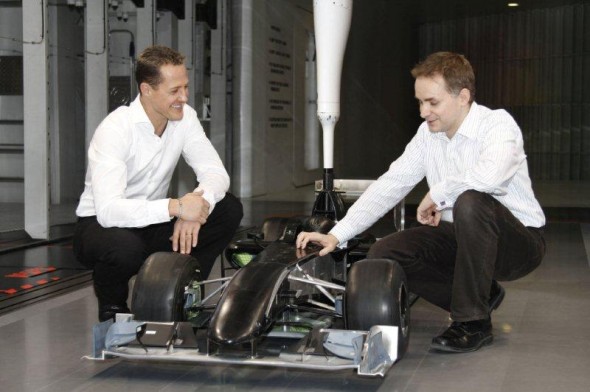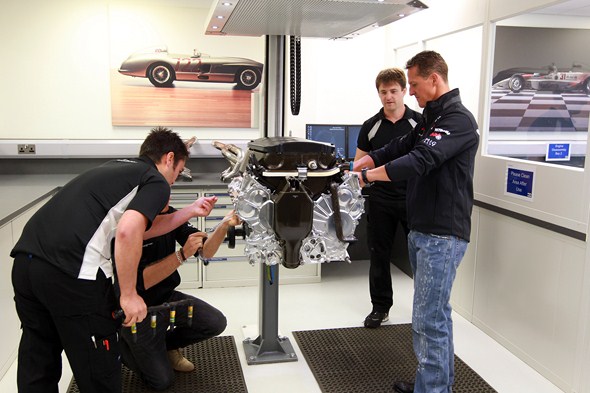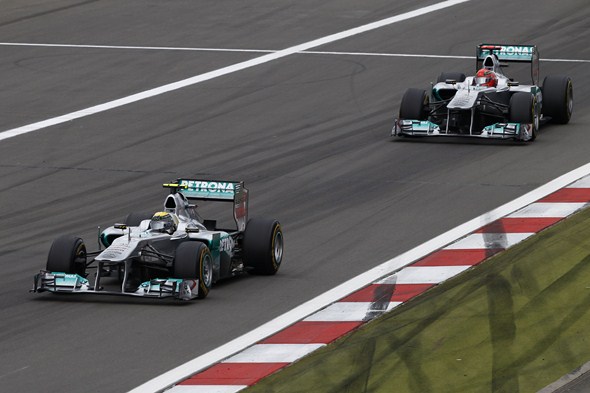MICHAEL SCHUMACHER JOINS MERCEDES GP PETRONAS

![]()

The MERCEDES GP PETRONAS Formula One Team can confirm today that seven-times Formula One World Champion Michael Schumacher will make his racing return in 2010 with the Silver Arrows team.
With seven Drivers‟ World Championships, 248 Grand Prix starts, 91 victories, 154 podium finishes and 68 pole positions, the 40-year old German needs no introduction following an illustrious and record-breaking Formula One career from 1991 to 2006 at the Jordan, Benetton and Ferrari teams.
Michael‟s return to racing with MERCEDES GP PETRONAS sees his return to Mercedes-Benz Motorsport where he began his racing apprenticeship as part of the Junior Programme in 1990, racing in Group C sports cars and DTM, and sees Michael renew his partnership with Ross Brawn with whom he won all seven of his World Championships.
Todays announcement confirms the MERCEDES GP PETRONAS driver line-up for the 2010 season with Michael partnering his compatriot, 24 year old Nico Rosberg, in the Silver Arrows cars.

Michael Schumacher
MERCEDES GP PETRONAS represents a new challenge for me both in a sporting and a personal context. It is a new chapter in my racing career and I am really looking forward to working with my old friend Ross Brawn and my companions from my days with the Mercedes Junior Programme. I am convinced that together we will be involved in the fight for the Formula 1 World Championship next year and I am already looking forward to getting back onto the race track. For me, this partnership closes the circle. Mercedes supported me for so many years when I began my Formula 1 career and now I can hopefully give something back to the brand with the star.”

Nico Rosberg
“It is fantastic that Michael is returning to Formula One and will be my team-mate at MERCEDES GP PETRONAS. It‟s a great challenge for me to be up against one of the best drivers of all time. I‟m sure that we will form a very strong partnership as he will have lost none of his speed! It is also great news for our sport and the fans.”
Ross Brawn
Team Principal of MERCEDES GP PETRONAS: “I am delighted that we can confirm today that Michael will make his much-anticipated return to Formula One next year and drive for our MERCEDES GP PETRONAS team. As seven-time World Champion, Michael‟s outstanding record in Formula One speaks for itself and I am looking forward to working with him again. With the completion of our driver line-up, I believe that we now have the most exciting partnership in Formula One with Michael and Nico, who provide the perfect mix of talent, experience, speed and youth. We can now turn our full attention to the preparations for the new season and everyone at MERCEDES GP PETRONAS is extremely excited about the challenge ahead. With the investment and support in our team provided by Daimler, Aabar and our new title partner Petronas, and with two such exciting drivers, we have all of the building blocks in place to have another successful season in 2010.”
Norbert Haug
Vice-President of Mercedes-Benz Motorsports: “In April 1991, when I had been in charge of the Mercedes-Benz Motorsport programme for just six months, Michael was standing beside me on the balcony one evening. Without the slightest doubt, he said in a low voice: “It‟s about time that I got into Formula 1″. Michael had just turned 22 years of age and four months later, he made his debut at Spa in a Jordan. Mercedes-Benz helped him to this point and the rest is history: seven World Championship titles, more than any racing driver, 91 Grand Prix wins, more than any racing driver. Michael has more of everything than every other driver. As part of the Mercedes Junior Programme, Michael had raced in Group C sports cars and competed in a few DTM races. Ross Brawn, then our opponent at Jaguar, quickly realised Michael‟s talent and they went on to win all seven of his Drivers‟ World Championship titles together at Benetton and Ferrari. Our sporting ambition has always been that Michael should drive again where his professional career had started and Michael knew that. We often joked about it after the races and discussed the prospect seriously several times during the last 14 years in Formula 1. It didn‟t happen in 1995, it didn‟t happen in 1998 and it didn‟t happen in 2005. I am delighted that it will now happen in 2010. I am very much looking forward to working with Michael and everybody at Mercedes-Benz and Daimler extends a very warm welcome to our „apprentice‟ of 19 years ago. That apprentice is now the most successful racing driver of all time.”





